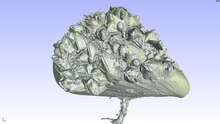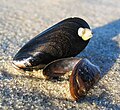Mytilus
| Mytilus | ||||||||||||
|---|---|---|---|---|---|---|---|---|---|---|---|---|

Mussel from the side, from below and unfolded with severed sphincter muscle |
||||||||||||
| Systematics | ||||||||||||
|
||||||||||||
| Scientific name | ||||||||||||
| Mytilus | ||||||||||||
| Linnaeus , 1758 |
The genus Mytilus is a worldwide distributed genus of mussels (Bivalvia) and the type genus of the family of mussels (Mytilidae).
anatomy
Mussels have a gray to blue-purple, fully grown shell about 5 to 10 centimeters long and an elongated oval shape. They follow the general blueprint of the mussels . They consist of a right and left half of the shell, which are held together with an elastic lock strap (ligament). The shell is made up of 3 layers: the top layer of organic material ( periostracum ), the middle thick layer of lime (ostracum) and the innermost, valuable, silver-white, shiny mother-of-pearl layer (hypostracum). In the shell cavity of the mussel there are two gills with gill leaves that are well supplied with blood. Between the gills is a muscular foot with the byssus gland. With the help of protein contained in the mussel and iron filtered from the sea, this gland produces the byssus threads with which the mussel can hold on. Mussels have a sphincter, which is located in the soft tissue of the mussel, as well as other organs (heart, stomach, intestines, kidneys). With the help of the sphincter, the mussel can close in case of danger or dryness.
nutrition
Mussels are filter feeders . They have two openings. The water enters the mantle cavity through the inflow opening, in which a permanent water flow is generated by the eyelash hairs. The tiny food particles (plant and animal plankton) stick to the mucous layer of the gills. Then the eyelash hairs convey the mucus in the gills with the food particles to the mouth of the mussel and from there to the stomach and intestines, where the food is ultimately digested. The indigestible residues are expelled from the outflow opening with the respiratory water.
Reproduction
Each spring and summer, the females lay five to ten million eggs, which are then fertilized by the males. The fertilized egg cells become trochophoric larvae, 99.9 percent of which are eaten in the course of their four-week development into juvenile mussels. Nevertheless, after this "selection" there are still around 10,000 young mussels left. These are about three millimeters in size and often drift around several hundred kilometers in the sea before they settle with their byssus threads with a size of about five centimeters in coastal regions. The reason mussels live in such large colonies (also called banks) is because it gives the males a much greater chance of fertilizing eggs. After the larvae have developed freely as plankton for about four weeks , they attach themselves to stones, stakes, shill, sand and other shells with byssus threads . They prefer the brackish water from estuaries and mud flats in the coastal regions.
Enemies
Natural enemies include starfish and whelks , which wait for the mussel shells to open and then eat the mussel. Numerous vertebrates also eat mussels, such as walruses , fish such as flounder and plaice , lesser black-backed gulls , oystercatchers and ducks .
They are only allowed to be fished by humans according to strict guidelines and from specially designated aquacultures. Mussels are not only fished for human consumption, they are also used as fertilizer, bait for fishing, food for aquarium fish and occasionally to fortify pebbly shorelines, as in the English county of Lancashire .
In 2011, the Wadden Sea Protection Station announced that there were apparently fewer and fewer mussels in the Schleswig-Holstein Wadden Sea National Park . Even the protected stocks on the tidal flats have declined by 79 percent over the course of 20 years.
Mild winters make the situation more difficult, because then the predators of the young mussels - such as starfish, snails or birds - are almost always present.
Self-protection
The shell of the mussel is used for protection, it can be closed suddenly with the sphincter in case of danger. Mussels can stay there for weeks. The Adriatic mussel Mytilus galloprovincialis produces toxic oxazinins as a defense substance ; other species contain saxitoxin ingested with food - from dinoflagellates .
Mussels as food
Some types of mussels are the most important edible mussels , ahead of oysters . These mainly in Atlantic , North and Baltic occurring Mytilus edulis and Mytilus galloprovincialis of the Atlantic and the Mediterranean (see mussels from Galicia ). They have been grown in cultures on wooden stakes in France since the 13th century, and mussels have been known in Galicia since they were colonized by the Celts. Today they are also cultivated on the Dutch, German and Italian coasts. Every year around 550,000 tons of mussels are traded in Europe, around 250,000 tons belong to the species Mytilus galloprovincialis and come from the aquacultures of Galicia.
Rhenish-style mussels are a common preparation variant . In Belgium and northern France, the mussels are often served with French fries as moules fries .
In the absence of sanitary checks , mussels can in rare cases lead to mussel poisoning if they have consumed plankton that are toxic to humans; a few people are also allergic to their protein and therefore also react with symptoms of poisoning. Before they can be prepared, the mussels must still be alive, i.e. keep their housing closed or close it when it is tapped. If they remain open, they should be thrown away. Mussels that remain closed after cooking are also considered inedible, although this statement is questioned.
Occasionally, occasionally often, small crustaceans live inside mussels, the mussel guards , which feed on the plankton filtered out by the mussel. They are annoying, but safe to eat.
Mytilus edulis
Mytilus edulis (Latin edulis = edible), an edible mussel, is also known as the blue mussel in Northern Europe. The black-blue-violet surface and the oval shape are characteristic. The mussel can grow up to a size of ten centimeters. It usually populates seas and bays and can be found in brackish water as well as in salt water .
photos
Receipts and web links
literature
- Elizabeth Gosling: The Mussel Mytilus. Ecology, Physiology, Genetics, and Culture (= Developments in Aquaculture and Fisheries Science. Vol. 25). Elsevier, Amsterdam et al. 1992, ISBN 0-444-88752-0 .
Individual evidence
- ^ Mussels threatened in the Wadden Sea , taz.de, September 15, 2011.
- ↑ WWF press releases on fishing in the Wadden Sea since 2002 ( memento of the original from August 3, 2017 in the Internet Archive ) Info: The archive link has been inserted automatically and has not yet been checked. Please check the original and archive link according to the instructions and then remove this notice. (PDF; 255kb), as of July 2014.
- ↑ Mussels in the Schleswig-Holstein Wadden Sea are threatened: Wadden Sea Protection Station and WWF are calling for an end to the overuse of the national park by mussel farming. News from the Wadden Sea Protection Station from September 15, 2011.
- ↑ country people press service: [1]
- ↑ Patrizia Ciminiello, Caramela Dell'Aversano, Ernesto Fattorusso, Martino Forino, Silvana Magno: Toxins from Adriatic blue mussels. A decade of studies. (PDF; 271 kB) In: Pure and Applied Chemistry. Vol. 75, No. 2/3, 2003, ISSN 0033-4545 , pp. 325-336, doi : 10.1351 / pac200375020325 .
- ↑ Vladimir Rydl: Mussels , Planet Wissen, March 22, 2007.
- ↑ Christoph Drösser : Maritime sphincter (why you can safely eat mussels that remain closed after cooking) , zeit.de of November 20, 2008.
- ↑ Blue Mussels: An Open and Shut Case. (PDF; 174 kB) ( Memento of the original from February 18, 2011 in the Internet Archive ) Info: The archive link was inserted automatically and has not yet been checked. Please check the original and archive link according to the instructions and then remove this notice. In: Fish. 6/2007.
- ↑ Wolfgang Blumenthal: Does a crab spoil the mussels? , SHZ of August 8, 2008.
- ↑ Poul Bondesen: Danske havmuslinger . Naturhistorisk Museum, Århus 1991, ISBN 87-89137-24-8 .
Web links
- More information from the Wadden Sea Protection Station
- Recipes and preparation options in the Koch-Wiki
- www.wissenschaft.de: Why don't let go of the lousy mussels - An iron particle holds shellfish on almost any surface
- www.wissenschaft.de: What makes mussels so sticky - a component of the adhesive proteins attaches to inorganic or organic surfaces, depending on the conditions
- Mussel fishing in the Wadden Sea






